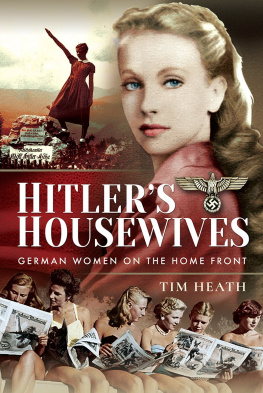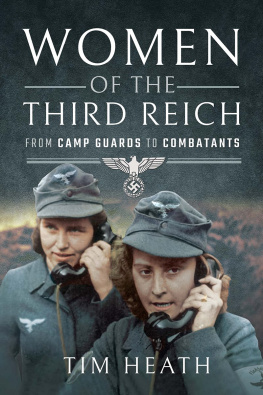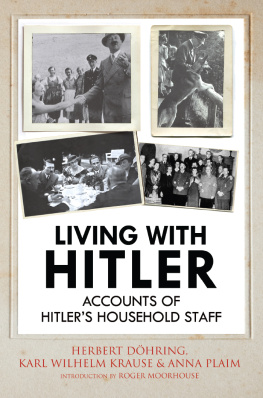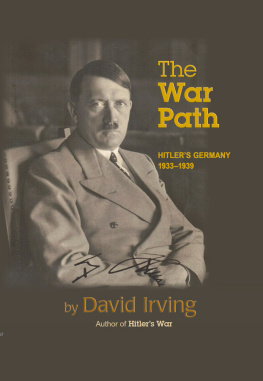Creating Hitlers Germany
Creating Hitlers Germany
The Rise of Extremism
Tim Heath
First published in Great Britain in 2019 by
PEN AND SWORD HISTORY
An imprint of
Pen & Sword Books Ltd
Yorkshire Philadelphia
Copyright Tim Heath, 2019
ISBN 9781526732989
eISBN 9781526732989
Mobi ISBN 9781526732996
The right of Tim Heath to be identified as Author of this work has been asserted
by him in accordance with the Copyright, Designs and Patents Act 1988.
A CIP catalogue record for this book is available from the British Library.
All rights reserved. No part of this book may be reproduced or transmitted in any
form or by any means, electronic or mechanical including photocopying, recording
or by any information storage and retrieval system, without permission from the
Publisher in writing.
Pen & Sword Books Ltd incorporates the Imprints of Pen & Sword Books
Archaeology, Atlas, Aviation, Battleground, Discovery, Family History, History,
Maritime, Military, Naval, Politics, Railways, Select, Transport, True Crime,
Fiction, Frontline Books, Leo Cooper, Praetorian Press, Seaforth Publishing,
Wharncliffe and White Owl.
For a complete list of Pen & Sword titles please contact
PEN & SWORD BOOKS LIMITED
47 Church Street, Barnsley, South Yorkshire, S70 2AS, England
E-mail:
Website: www.pen-and-sword.co.uk
or
PEN AND SWORD BOOKS
1950 Lawrence Rd, Havertown, PA 19083, USA
E-mail:
Website: www.penandswordbooks.com
In Memory of 4919046 Fusilier, Alfred Heath, 2 nd Battalion Lancashire Fusiliers, killed in action, aged 23, on 17 August 1943, Italy, and Siegfried Strelow, killed in action, aged 18, on 1 March 1945, Silesia.
At the going down of the sun and in the morning, we will remember them.
Introduction
C reating Hitlers Germany was not written with the intention of producing a chronological analysis of Germany throughout its most troubled, if not darkest, period in its history but to try and understand what social and political factors influenced its aggression through the earlier part of the twentieth century. From testimonies in the form of personal letters, notes and diary entries, plus first-hand accounts, Creating Hitlers Germany not only attempts to understand Germanys pursuit of world domination but also its journey to genocide. It also examines Germanys eventual destruction and the reciprocal genocide that was visited upon the country itself at the close of the Second World War in 1945. This work is unequalled in its mix of life, love and tragedy, all intertwined with the horrors of war, as witnessed by those who were there and who lived to tell the tale. The previously unpublished story of Werner, Hilde and Alexander Kohlman provides a unique introduction to the work and, along with the private diaries and letters of young Jewish socialite Melitta Jorg, contributions from the private family archives of Albert and Emira Friest, Ingrid and Andreas Hoess, Paulina Rischner and Ursula and Rudi Metschuldt, plus many other first-hand accounts, makes Creating Hitlers Germany essential reading if one is to understand the very embryo of Adolf Hitlers Third Reich.
These unheard voices, reminiscences and collective experiences of a generation effectively conceived upon a bed of bayonets are still very much the source of fascination and, sometimes, revulsion. In many cases, the natural curiosity that we historians possess to document and preserve what are merely segments of Third Reich history means that we are often ignorant as to their importance in the modern world. Germany was a nation with the deep resentment that resulted from Versailles woven into its social fabric. After 1918 the country found itself caught in a trap and, like a desperate wild animal in the same predicament, was ready to chew through a snared limb in order to free itself. The foundations for the rise of a dictatorship, such as that of Adolf Hitlers Nazi Party, were in a sense set by those nations who had emerged victorious from the First World War. It is easy, after the passing of so many years, to discuss alternative scenarios. Solutions that may have prevented a Second World War involving Germany matter no longer within our modern hindsight. There are many essential lessons to be learned in order to prevent such catastrophes occurring again. Creating Hitlers Germany represents a nations journey not only through everyday life and the war but also through its own conscience, pain and inevitable search for some form of absolution from its past. For thousands of Germans, the birth of Hitlers Third Reich represented hope and salvation from the despair of Versailles. However, it soon came to represent abuse, suffering, discrimination, fear, intimidation and mass murder. Why did so many follow such a fratricidal regime so willingly to their own destruction? Why did many otherwise good men become murderers in the heat of battle? And why have so few spoken out on the reciprocal genocide visited upon the Germans themselves at the closing stages of the Second World War? I feel that the answers, or at least some of them, will be discovered within the pages of this unique book as they are given by those who were there.
The devil whispered to the soldier, A storm is coming.
The soldier replied, I am the storm.
Chapter One
Love Before War
W erner Kohlman and Hilde Schramm had been born and raised in the city of Hamburg. They had known each other for a great many years. They had both attended the same school, sharing the same group of friends. They both loved books, particularly those on ancient fairy tales. Neither owned many books, but the few that they possessed between them had great sentimental value. As children they talked of how they wanted to travel the world when they were old enough to leave home. They had the same dreams and aspirations as any other children. They both came from what can only best be described as working-class backgrounds. Their upbringing was harsh at times and they and their parents often had very little. It was, in many respects, a subsistence existence based upon the hopes and dreams of adulthood. Their homes were small terraced houses built mainly for the shipping and railway workers. In these cramped houses families shared bedrooms and it was not uncommon for several boys and girls to have to share a single bedroom. In wintertime the houses were cold and damp, and water leaked in through ceilings and walls whenever it rained. In the summer conditions were a little better, as the children played on the streets outside their homes or basked in the sunshine.
Werner and Hilde would often walk the short distance to their local school together. They would chat about all manner of things as they did. Hilde often stopped to pick a few flowers from the gardens of houses along the way. On one occasion, an angry old lady charged out of her home to confront Hilde about stealing her flowers. Werner grabbed her by the hand and they ran away laughing. Later at school their escapade of earlier in the day was reported. Hilde was called to the front of their small class to receive a verbal rebuke from the headmaster. For his part in the crime, Werner was made to lie across the headmasters heavy oak desk and given a thrashing with the cane across his backside. Hilde tried to explain that the deed was all her fault, but this did not save poor Werners buttocks from the stick. As they walked back home that day, Hilde was very concerned for her friends predicament. Werner tried to reassure her with the words, It didnt hurt that much, to which Hilde replied, Well, why were you crying then? Instead of becoming angry with Hilde, Werner just laughed. They parted at the end of their street, each going their separate ways, saying they would see each other tomorrow. As they grew older, the routine continued. They spent much time in each others company, reading and discussing stories they had heard from grown-ups.














